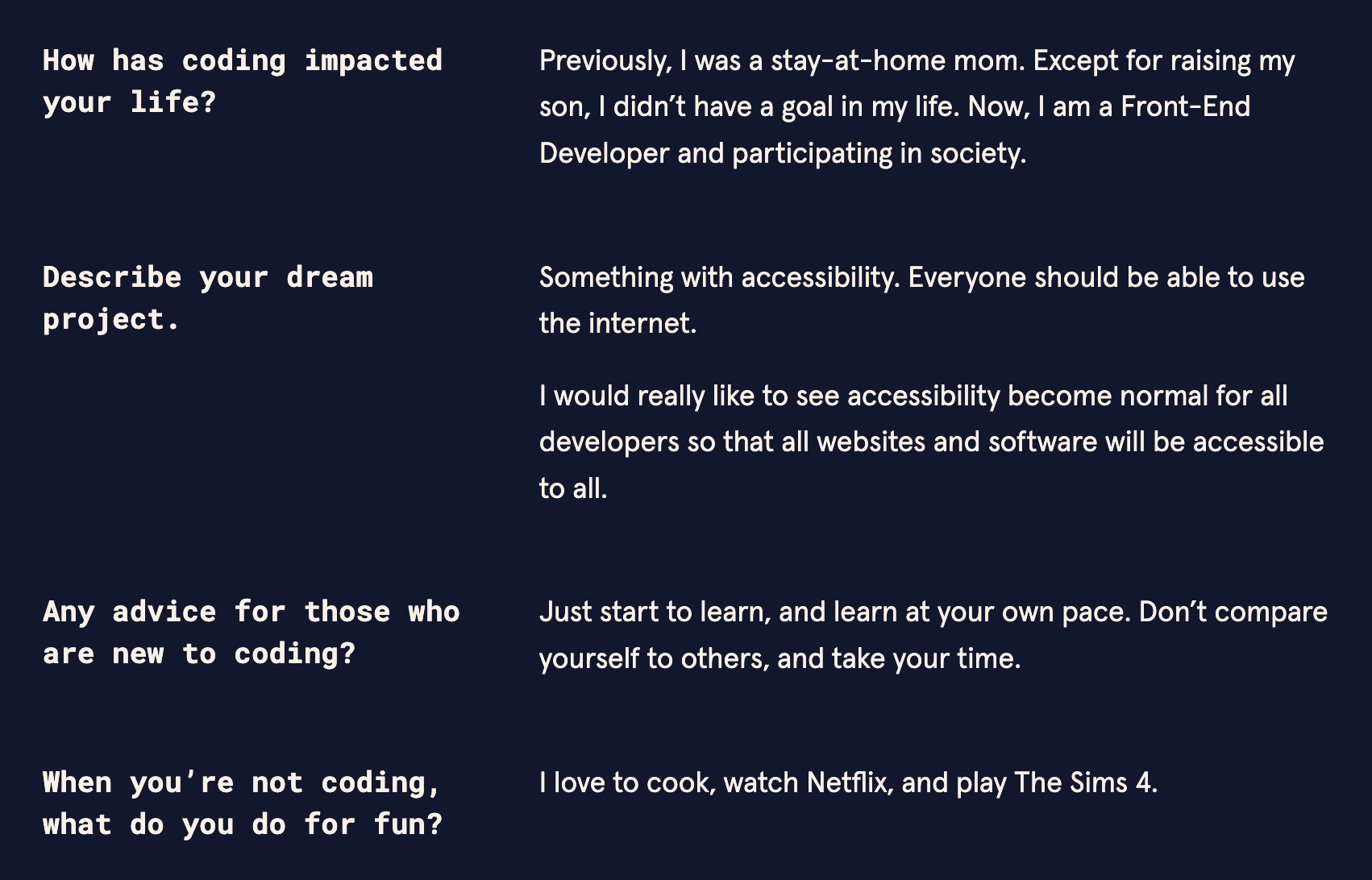Trust is a critical factor in building relationships with your customers. With all the similar products or services on the market, they need to know that yours is just right for their needs.
Customer stories highlight your offering in practical, real-world scenarios that prospective buyers can relate to. They go beyond the testimonial one-liner to dive into the benefits and details of specific use cases.
In this article, we’ll explain how to use customer stories to increase your credibility. We’ll include three examples of different customer story styles and share five top tips to write your own.
What are customer stories?
A customer story is a narrative that describes someone’s experience with your company or product. It is a form of value selling that generally highlights the results and benefits rather than features.
Instead of presenting dry data, customer stories humanize your brand by providing first-hand details of how your product has improved someone’s life or contributed to real results.
This makes customer stories extremely relatable for people who want to achieve the same outcomes. They’re also ideal content marketing for capturing “bottom of the funnel” prospects, who are in the consideration phase of the customer journey. These potential buyers are still assessing your offer, likely against the competition, so showcasing positive results can help influence conversions.
There are three main types of customer stories:
Testimonials (can be written quotes or videos)
Reviews
Customer stories can be a collaborative process between you and the customer, but they can also be as simple as a comment on social media you choose to highlight.
Say a customer messaged you on LinkedIn to say they have a much better quality of life now after using your nutritional plan. You could then ask if they would be happy with you sharing a screenshot of the comment on your main feed.
Note: You should always have permission from the person you’re quoting to use their words for marketing purposes.
What are the benefits of sharing customer stories?
According to a 2021 US survey, almost 61% of respondents said they always viewed online reviews before buying. Almost all respondents (99.9%) said they at least sometimes read reviews when shopping online.
When consumers are figuring out the right way to react to an unknown situation, they tend to base their decision on what others are doing. This type of confirmation, known as social proof, is especially important for digital experiences where there’s no physical product involved.
When potential leads land on a SaaS or agency website, they may not be quite ready to buy yet. With physical products, there’s a comfort in knowing they can return something if it doesn't suit them. However, that option may not be available when paying for a service. You can use customer stories as a way to begin building trust in your service.
Create a genuine customer experience and boost your credibility
Social proof is such a strong persuasion factor because it feels genuine. Consumers trust other consumers and are keen to hear about other real-world experiences with a product before they decide to buy it.
User-generated content (UGC) is original, brand-specific content that’s created by consumers. It can take many forms, including photos, videos, illustrations, reviews and more. It’s grown phenomenally in popularity, especially on social media, because it feels more authentic than branded content.
Research shows that 84% of respondents are more likely to trust a brand that uses UGC. Around 77% also agreed they would be more inclined to purchase the brand’s products or services.
Reduce churn and encourage higher retention
While customer stories are helpful for prospects who are still sizing up your company, they can also impact current customers. Existing buyers may also learn new things about specific features or functionality that could improve their own experience.
In a real-world scenario, consider B2B messaging service Slack’s use of customer stories.

The company has grown more popular thanks to digital transformation in the workplace as more teams work remotely or asynchronously. Slack targets a specific niche and uses its customer stories to highlight well-known brands in its niche to speak to its trendy, tech-minded target market.
Slack’s customer stories page inspires buyer confidence by using highly recognizable brand logos and scannable headlines about how it helps big companies succeed.
Optimize sales cycles with instant resources
Social proof can also give your sales team leverage with undecided prospects. Having real use cases on hand allows team members to quickly send these experiences to leads looking for similar results.
Customer stories also allow sales reps to make the best use of their time because they’re not having to spend time plugging your product or service’s credibility.
3 examples of customer success stories
If your product or service is complex, showcasing different use cases can help users see what the experience is like.
As mentioned, customer stories come in different forms, such as video testimonials and written case studies. The type of story you choose will depend on several company factors, like your brand voice and resourcing abilities.
Here we’ll explore three brands that show how to effectively use each type of customer story best suited to the product or service they offer.
Product reviews: Wandering Bear Coffee
While reviews are important for all e-commerce companies, they’re especially critical for food and beverage products. Consumers know how your marketing team says something tastes, but they usually want confirmation from real customers before taking a chance.
Wandering Bear Coffee, a small business with a big brand, uses a simple carousel layout and conversational copy for their “Real emails from other humans”.

The reviews are in the voices of customers (with all caps and extra exclamation points to prove it), which helps them feel down-to-earth and genuine. Below the fold, there are many more star-rated reviews to assess.
Video testimonials: Marucci
When asked how they’d most like to learn about a product or service, 73% of respondents in a survey agreed they’d prefer to watch a short video.
Marucci is a sports equipment manufacturer that specializes in baseball gear. They edited a mix of video testimonials from athletes together to show their bats in action:
Not only do they use footage of the product in use, but they also piece together clips that highlight specific benefits for different batters and catchers.
While this video has a lot of production value, yours don’t have to be as polished. The rise of social media platforms like TikTok has proved that authentic, self-filmed videos will likely be even more relatable.
Case studies: Amp Agency
Case studies are important evidence for agencies and the services they provide. These usually have to be far more detailed and include more data than testimonials.
Amp Agency has a wide range of big-name case studies available on their site. Showing that huge brands trust them adds another layer of social proof and increases their credibility.
One particular case study lays out how the agency reduced Microsoft’s Xbox call center costs by creating streamlined online support experiences for customers. Here’s a quote from the case study:
The write-up has just the right balance of detail to show the value of their service. It doesn’t give away too many secrets, but there’s enough information to give potential customers confidence and justify the cost.
While you may think you need to include customer quotes for a good case study, Amp Agency doesn’t tend to use them. This is a helpful factor for minimizing barriers when asking for permission to use a customer story, as you may already have all of the information you need.
5 tips for creating your own customer stories
By putting the focus on your customers and their experiences, you can deliver valuable insights that will benefit your business and prospects equally. Instead of trying to convince your reader with logic, you can persuade them by helping them resonate with an engaging story and an emotional hook.
Here are five tips that will help you create customer stories with different customer types that build the genuine desire to buy.
Tip 1: Collect customer stories organically
If you’re a customer-centric company, you will likely have lots of positive feedback available to choose from. These are some of the most popular places to find and collect customer comments organically:
Social media. Twitter is one of the best platforms for finding positive comments as it’s publicly available and easy to search. Others, like Facebook and Instagram, may be a little more difficult due to privacy settings.
Grateful emails. These are usually more thought-out and detailed than a social media comment.
Customer support channels. Whether you use a business messaging app, chatbot or direct messages on social media, check old support tickets that have had positive resolutions.
Any other channels you have available for feedback. This could be the comments section on your site blog, Your Google Maps listing, your community forum or your “Contact Us” form, for example.
Wherever you find feedback you’d like to use, ask permission to quote the customer for marketing purposes to avoid any potential issues down the line.
If you need to edit typos or incorrect grammar, send it back to them to double-check they’re happy with the final version and ensure it stays authentic.
If your product is new to the market, you may not have any of these options yet. In this case, you could think about offering groups of people a free trial in exchange for honest feedback.
Tip 2: Timing is everything
An effective sales CRM means you’ll always have existing customer data on hand. Knowing exactly where all prospects and customers are in the sales cycle makes when you should contact them clearer.
You may already have a customer success manager who can tell you the best people to reach out to when the time comes. Otherwise, consider adding surveys or feedback options to your site at certain stages of the customer journey.
You may wish to offer an optional survey when customer support fixes a problem or if someone contacts your sales team to say thank you. You can use automation to send immediate follow-up emails asking for feedback. Asking the right questions at the right time will give you the best chance of optimum feedback.
It can also help to plant the seed of customer stories in advance. For instance, mention during onboarding that you regularly share them on your site or social media platforms. Noting someone’s reaction when you say they may be asked to participate could help you gauge whether they’d be a reasonable candidate in the future.
You may also choose to ask for stories at scheduled touchpoints like check-in calls or after customer surveys. One of the most effective times is at or after the “attribution point” in the customer journey. This is when the customer has had sufficient time to weigh up the results of your product or service.
This could be weeks or even months into the customer journey, depending on your industry, but it’s important to give people enough time to form a well-rounded experience. This may also give you more of a chance to build a meaningful relationship with them.
Tip 3: Sharpen your interview tactics
Often, a personal interview can get you more detailed stories. The way you portray a customer story can have a big impact on its effectiveness. Anyone on your team can share short quotes on social media, but long-form articles and video testimonials will likely require more creative input. That’s where interviewing comes in.
Think about how you’ll structure your interviews before you conduct any. Will you have a set of questions that you ask everyone? Will you record a live interview or email your questions and request written responses?
For instance, take a look at the written question and answer format of this learner story from Codecademy:

This is a direct, effective format for sharing on your website.
If you want a more dynamic medium, consider doing an interview on camera. Here are some quick tips for successful video testimonials:
Choose confident and charismatic customers who will come across as genuine
Create and send questions in advance to ensure there’s time for both sides to prepare
Warm up with light conversation to make the customer feel comfortable
Keep the interview short and sweet to maximize engagement for those watching
Make sure you and your interviewee have the right equipment to record good-quality video and audio
What if you encounter someone who isn’t a confident writer but doesn't want to be filmed?
In those cases, you could offer to write a case study for them based on verbal answers that they’ll check and approve before you post publicly.
Whatever style you go for, the end result should feel genuine rather than scripted.
Tip 4: Highlight the benefits to customers of being involved
Asking for someone to take time out of their busy day to share their story can be a big request. It can sometimes help to explain what case study candidates will get out of the experience.
For instance, if your site has a high domain rating (which means you’re more likely to rank highly in search engines), linking back to the customer’s site could also boost their rating. You may have a large social media following that will help boost your customer’s exposure and brand awareness.
Most people will likely be happy to participate, but keep these tips in mind to ensure a good experience and quality story as a result.
Try not to put people on the spot or in a position where they feel they have to agree
Whether it’s face-to-face or over email, it’s good practice to keep your pitch short and sweet
Covering important details about what you’re asking for upfront so customers won’t have to ask (e.g. how long it’ll take or what the end product will be like)
Give them the questions ahead of time so they can prepare answers to more in-depth questions in advance
It shouldn’t be difficult (or costly) to get people to participate. You can offer discounted pricing or other perks to get people involved, but the beauty of customer stories is that they stem from positive experiences. Mostly, people will be happy to share these as long as you make the process of collecting them seamless.
Tip 5: Encourage different departments to collaborate for deeper insights
Aligning sales and marketing, also known as “smarketing”, can help team members create relatable customer stories. Our State of Sales and Marketing report found that companies where these two departments were well-integrated exceeded growth forecasts nearly twice as often as companies with poorly integrated departments.
Being proactive and creating streamlined workflows between teams makes it much easier to gather relevant data for customer stories. Whether you’re in healthcare, financial services or real estate, encourage collaboration across your sales and marketing departments for deeper insights.
Final thoughts
Customer stories are a form of social proof that gives people the confidence to do business with you. Seeing that someone else has achieved the outcomes they’re looking for, and perhaps enjoyed the experience too, is often the nudge some customers need to make a purchase decision.
Crafting the perfect pitch will give you the best chance of acquiring the best stories – making them a valuable and flexible asset for your sales and marketing teams. Focus on storytelling and let authentic experiences from customers do the selling for you.






